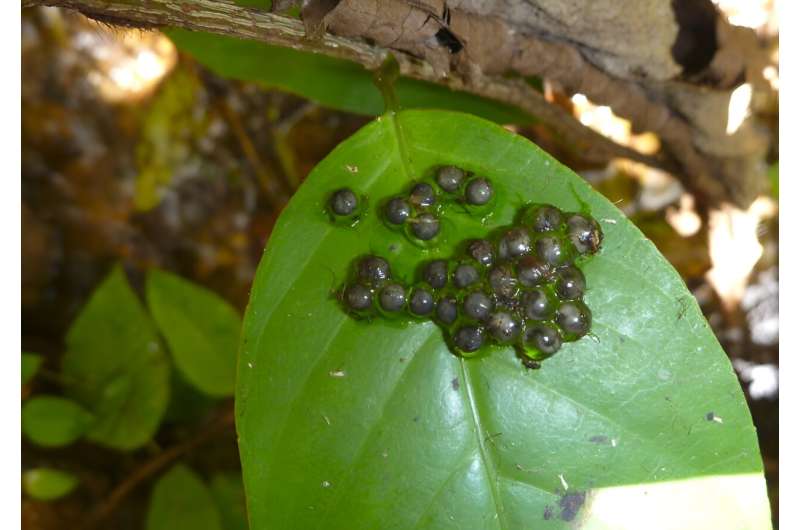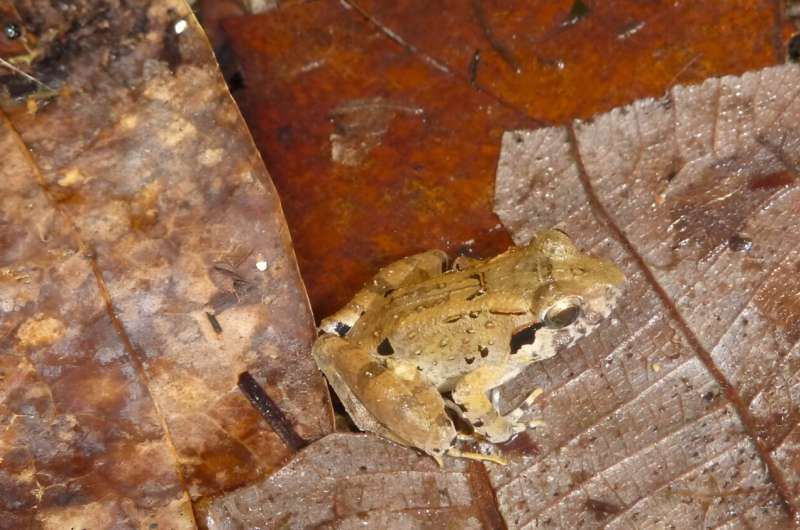A new species of fanged frog, Limnonectes phyllofolia.Photo credit: Sean Reilly
Generally speaking, frog teeth are nothing to write home about, they look like little pointy pins on the roof of the mouth. But a group of stream-dwelling frogs in Southeast Asia have a strange adaptation: two bony “fangs” protruding from their mandibles. They use these fangs to compete for territory and mates, and sometimes even to hunt hard-shelled prey such as giant centipedes and crabs.
A new study published in the journal PLOS Oneresearchers describe a new species of fanged frog: the smallest frog ever discovered.
“The new species is small compared to other fang-toothed frogs on the island where it was found,” said Jeff Frederick, a postdoctoral fellow at the Field Museum in Chicago and lead author of the study. one the size of one.” As a doctoral student at the University of California, Berkeley. “Many frogs in this genus are huge, weighing up to two pounds. The maximum weight of this new species is the equivalent of a dime.”
A team from Berkeley’s McGuire Laboratory, working with the Bogor Museum of Zoology, discovered the frog on Sulawesi, a rugged, mountainous island in Indonesia. “It’s a huge island with a vast network of mountains, volcanoes, lowland rainforest and mountain cloud forests. The presence of all these different habitats means the scale of biodiversity in the many plants and animals we find there is unparalleled , such as Amazon,” Frederick said.
While hiking through the jungle, members of a joint U.S.-Indonesian amphibian and reptile research team discovered something unexpected among the leaves of saplings and moss-covered boulders: nests of frog eggs.

The new species of frog lays its eggs on leaves.Photo credit: Sean Reilly
Frogs are amphibians that lay eggs that are encased in jelly instead of a hard protective shell. To prevent the eggs from drying out, most amphibians lay their eggs in water. To the team’s surprise, they kept finding terrestrial egg masses on leaves and mossy boulders just a few feet above the ground. Soon after, they started seeing little brown frogs.
“Typically, when we look for frogs, we scan the edges of riverbanks or wade across streams to find them directly in the water,” Frederick said. “However, after repeatedly monitoring the nests, the team began to see participating frogs sitting on leaves and hugging their nests.” This close contact with the eggs allows the frog parents to coat the eggs with compounds that make them Keep it moist and free from bacterial and fungal contamination.
Close examination of the amphibian parents revealed that not only were they tiny members of the fang-toothed frog family, with barely visible teeth, but that the frogs caring for the eggs were all male. “Male egg-keeping behavior in all frogs is not completely unknown, but it is quite rare,” said Frederick.
Frederick and his colleagues speculated that the frogs’ unusual reproductive behavior may also be related to their smaller-than-usual fangs. Some frog relatives have larger fangs, which help them avoid competing for spawning sites along rivers. Since these frogs have evolved a way to lay their eggs away from water, they may no longer need such huge fangs. (The new species’ scientific name is Limnonectes phyllofolia; phyllofolia means “leaf nest.”)
“What’s fascinating is that with each subsequent expedition to Sulawesi, we still find new and diverse breeding patterns,” Frederic said.
“Our findings also highlight the importance of protecting these very special tropical habitats. Most of the animals that live in places like Sulawesi are very unique, and habitat destruction is highly critical to protecting the species we find there.” Understanding animals like these frogs found nowhere else on Earth could help protect these valuable ecosystems.”
More information:
A new species of terrestrial fang-toothed frog (Tailless: Dicroglossidae) from Sulawesi, Indonesia. PLOS One (2023). DOI: 10.1371/journal.pone.0292598
citation: World’s smallest “fanged” frog discovered in Indonesia (2023, December 20) Retrieved December 21, 2023, from https://phys.org/news/2023-12-world-smallest- fanged-frogs-indonesia.html
This document is protected by copyright. No part may be reproduced without written permission except in the interests of fair dealing for private study or research purposes. Content is for reference only.
#Worlds #smallest #fanged #frog #discovered #Indonesia
Image Source : phys.org
